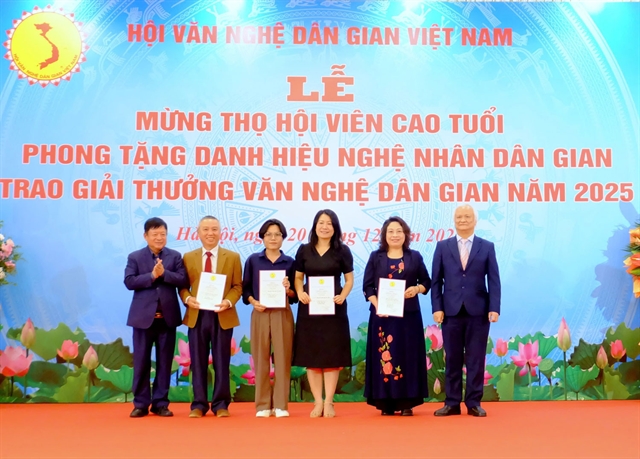 Opinion
Opinion
.jpg)
Architect Ngô Viết Sơn, talks to the Tuổi Trẻ (Young People) newspaper on what the Đà Lạt authorities should do to manage the city’s development.
 |
| Many people have blamed tourism overcrowding for the traffic congestion in Đà Lạt. — Photo thanhnien.vn |
Architect Ngô Viết Sơn, talks to Tuổi Trẻ (Young People) newspaper on what the Đà Lạt authorities should do to manage the city’s development.
Many people have blamed tourism overcrowding for the traffic congestion in the Central Highlands’s Đà Lạt City. Do you agree?
I don’t think so. Tourism is just one factor contributing to the problem. On the other hand, this is an indication that Đà Lạt has become a favourite choice for tourists because of its beautiful scenery and its nice people. This has become a motivation for the city to develop.
It is indisputable that if many people come to a small space, they will make the place overcrowded. But in my opinion, Đà Lạt is not small in term of its size. At present, Đà Lạt’s population is around 300,000 people, and every year it welcomes some 5 million visitors. Based on these facts, I think that Đà Lạt still can accommodate more visitors. According to French experts, by 2030, the population in the city will reach some 700,000 people and it will be able to welcome some 10 million visitors.
At present, the most congested place in Đà Lạt is the Hòa Bình area. Hòa Bình is a small area in the centre of Đà Lạt City. It cannot cope with a large crowd of tourists, coupled by the heavy transport activities there. Further more, there is a big bus station in the Hòa Bình area.
Do you mean that the local authorities should renovate the city’s central area?
What I mean is that the authorities there must redefine the city’s centre. The Hòa Bình area should not be selected as the city’s centre for its course of development.
According to the 2014 master plan for development, two main heritage sites, namely the Trần Hưng Đạo-Trần Phú route and the Hòa Bình area, have been chosen as the centre for tourism development and services. I don’t have any comments on the selection of the two main heritage sites, but regarding the Hòa Bình area, it should be a part and parcel of the Đà Lạt City.
Why? Because Hòa Bình’s area is too small while its construction density is too high. The area is already overcrowded. In my opinion, the centre are should be expanded from the Hòa Bình area to the Xuân Hương Lake. Even for all the projects which were developed by the French before 1954, the Xuân Hương Lake was selected as the centre, not the Hòa Bình area. So in my opinion, the Xuân Hương Lake will serve as a centre of Đà Lạt City.
Meanwhile, the Hòa Bình area should remain intact with no new big buildings to be erected, just like trade centres or big hotels and others. If the city authorities want to make a bit of change over there, they should only allow the construction of small buildings – but not for the purposes of economic benefits or service industry.
What I want to emphasise is that the planning of Đà Lạt is quite different from that for HCM City or other delta urban areas. What I want to emphasise is that Đà Lạt City, in the past, at present and in the future must be a space of “greenness and water surfaces”. It can’t be a space of tall and modern buildings.
At present, the number of private vehicles in Đà Lạt grows by an average of 12 per cent a year while the flow of visitors coming to Đà Lạt has been on a rapid increase. No doubt, the city will face the problem of traffic congestion, don’t you agree?
Tourists coming to Đà Lạt by whatever transport means is a natural thing as they can’t go on foot. And Đà Lạt City can’t open an eight-lane road to welcome the visitors as that will destroy the beauty of the city. Accordingly, the Hòa Bình area – Đà Lạt’s conservation area will be affected. It is projected that even if the Đà Lạt City’s centre is enlarged, it will not be able to cope with the increase in the number of cars coming to the city at the peak time of tourism. So in my opinion, it is time for the Đà Lạt authorities to think of developing a system of electric cars running along all roads leading to the Xuân Hương Lake and the surrounding areas. That means, when the tourists arrive in Đà Lạt in their cars or coaches they will transfer to electric cars to go to the city centre.
There is a suggestion that we should advise the local people living in Đà Lạt City’s centre to move to the outlying areas to reduce pressure for the inner city. What do you think about that suggestion?
If the city centre is expanded with the Xuân Hương Lake serving as its epicentre, I’m pretty sure that Đà Lạt City will be able to welcome an influx of tourists ten times larger than the current figure. This idea is totally in line with the plan to have more satellite cities towards the areas of Đức Trọng, Lạc Dương and Đơn Dương. This is a good and workable plan for the conservation and development of the city centre while creating a balance in the development of an urban area.
But, what we need to do right now is to have workable solutions to solve some hot spots, to protect the city centre and to leave good impressions on the visitors when they come to Đà Lạt.
Do you have any comments on the plans to build many high rises in Đà Lạt City?
Well, in the planning proposal, the limited height of all new buildings will be between three-five stories only.
But, due to Đà Lạt City’s hilly topography we also have to consider carefully the height of each building in a certain area/region as well as the greenness buffer zone between residential areas as the cases of Hòa Bình and Ánh Sáng living quarters. — VNS
.jpg)



